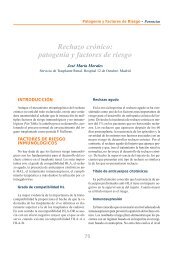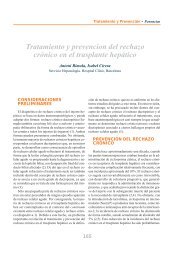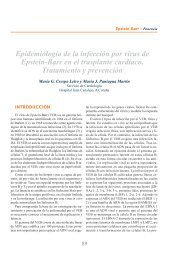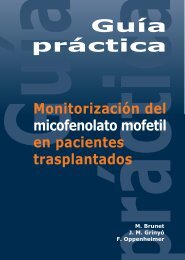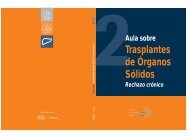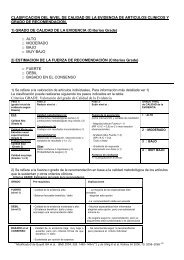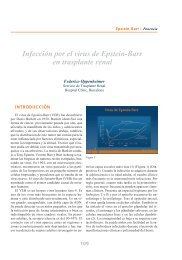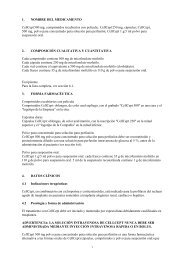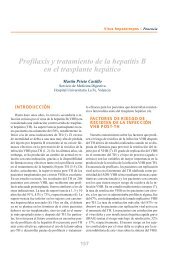Untitled - Roche Trasplantes
Untitled - Roche Trasplantes
Untitled - Roche Trasplantes
You also want an ePaper? Increase the reach of your titles
YUMPU automatically turns print PDFs into web optimized ePapers that Google loves.
BIOPSIA DE PROTOCOLO EN EL TRASPLANTE RENAL<br />
sistent in sequential biopsies in only a small percentage, but in this group of patients it<br />
halves the measured GFR in only 18 months (25). In a formal randomised controlled trial<br />
of detection and treatment of early subclinical rejection, Rush and his colleagues demonstrated<br />
a beneficial effect in terms of reduction of interstitial fibrosis and tubular<br />
atrophy at six months (26). More modern immunosuppressive regimens, including both<br />
tacrolimus and mycophenolate mofetil, have reduced the incidence of subclinical rejection<br />
and also the power to demonstrate the efficacy of treating subclinical rejection (27).<br />
The Banff schema does not at present recognize inflammation in areas of fibrosis and<br />
thus assumes that this infiltrate has no predictive value since the damage has been done.<br />
There are now several series that demonstrate that this is not true and that sub-clinical<br />
inflammation in areas of fibrosis are indeed associated with the presence of increased fibrosis<br />
in subsequent biopsies (28,29).<br />
Taken together, these data clearly support the view that inflammatory cells in renal allografts<br />
cause long term damage even in the absence of acute deterioration in graft function<br />
(30-36). In fact it is possible to support the contention that the damage is done because<br />
there is no associated rise in creatinine, allowing it to go undiagnosed and thus untreated.<br />
CNI nephrotoxicity<br />
The impact of CNI nephrotoxicity is the other major contender implicated in the development<br />
of CAN. It is possible to recognize chronic CNI toxicity and CAN as separate histological<br />
entities and some have argued that this should always be the case (37). In the<br />
two year protocol biopsies from the US multicenter trial comparing cyclosporine and tacrolimus<br />
(19), both the rate of development and the severity of CAN and chronic CNI toxicity<br />
were indistinguishable between tacrolimus, and the two formulations of cyclosporine<br />
(38). In the Westmead series chronic CNI toxicity was identified in biopsies by the<br />
presence of at least two of: striped interstitial fibrosis; arteriolar hylainosis; and tubular<br />
micro-calcification. It was an almost universal finding by ten years after transplantation.<br />
Interstitial fibrosis and tubular atrophy are highly correlated and progress rapidly in the<br />
first year, thereafter progressing slowly but inexorably up to ten years and beyond.<br />
Arteriolar hyalinosis<br />
Arteriolar hyalinosis was present in 75% of patients by ten years. While implantation biopsies<br />
may detect arteriolar hyalinosis in elderly, diabetic or hypertensive donors, in the series<br />
of young donors of simultaneous kidney pancreas transplants that we reported, arteriolar<br />
hyalinosis first appeared, sometimes transiently in the first three to six months<br />
(38). Early changes were correlated with higher trough concentrations of cyclosporine<br />
and by preceding episodes of acute CNI toxicity. The longer term and permanent appearance<br />
of chronic CNI changes by five years post-transplant, was associated with higher<br />
20




